Abstract
This paper provides the results of a 3D photogrammetric survey of the apsidal conch of St. Panfilo Church in Tornimparte (L’Aquila, Italy). The images were acquired and then processed in order to obtain a three-dimensional model available on Sketchfab platform. The five panels and the vault of the apsidal conch were exported from the 3D model as orthomosaics and then imported into CAD software for the mapping of the main degradation phenomena. The examined surface was almost entirely covered by mural painting and restoring mortars, the latter mainly located in the lower part of the apsidal conch. The whole surface of the apsidal conch was also examined by means of raking light that enabled highlighting of conservation problems and the presence of incision marks and giornata/pontate boundaries indicating the use of the fresco painting technique. Several degradation phenomena, attributable both to the executive technique of wall painting and the microclimate conditions, could be observed. According to the overlapping of weathering forms and the material involved, most of the examined surfaces exhibited moderate to very severe degradation.
1. Introduction
The work presented in this paper may be considered one of the first steps within the archaeometric project developed by the Italian Association of Archaeometry (AIAr) in the Church of St. Panfilo in Tornimparte (L’Aquila, Italy) aimed at studying the apse wall paintings attributed to the Italian master Saturnino Gatti that were produced in his workshop in a period between 1491 and 1494 [,]. The idea of the project was to study the conservation status, the original and superimposed materials and the degradation phenomena affecting the wall paintings with the aim of supporting the imminent restoration intervention. The project started in 2021 and followed a suitable approach starting from in situ documentation and investigation using different techniques that supplied relevant information on the conservation conditions, on the execution techniques and on the materials, but also helped in the selection of the points for sampling to perform subsequent laboratory analysis. Documentation of this National Monument is, in fact, the first and fundamental step required to correctly perform the restoration [,,,,,,].
With a view to supporting the work of the restorers, 3D photogrammetry, raking light documentation and mapping of the degradation phenomena affecting the painted surfaces of the apsidal conch were performed.
The standard UNI EN 16095 [] states the importance of collecting any information concerning the state of conservation of a monument. A two-dimensional system based on the acquisition of photographs, maps and textural notes represents a common approach for the recording of sampling points, alteration phenomena and the retouching of artworks and architectural elements []. On the other hand, further advantages can be provided using three-dimensional models [,,], permitting, for example, the observation of all information in a single file in which the 3D model can be easily rotated and explored. The method of 3D photogrammetry can be a valid and useful approach to obtain a 3D model that can be used as a working basis for inserting points of analysis, cleaning test areas, undertaking restoration interventions, mapping any previous interventions and, finally, viewing the paintings on platforms for sharing three-dimensional models, such as Sketchfab.
Part of the technical photography documentation can be obtained by means of raking light photography (RAK). This method allows the examination of monuments and archaeological materials, including, in particular, the observation of surface features (e.g., retouchings, lacunae, etc.), including those reflecting the painting technique, such as brush works, incision marks, as well as any other signs associated with the application of plaster and pigments [].
The damage mapping of wall paintings is a fundamental and preliminary step in each restoration project []. This step, in fact, supports proper planning of correct interventions and enables evaluation of the time and cost of the entire restoration work []. Moreover, mapping of the damage and degradation forms can help in determining the possible causes of the damage itself [,]. A well-established quantitative damage diagnosis procedure, consisting of the mapping of the materials forming the monuments, as well as the weathering forms affecting their surface, is described by the “Natural stones and weathering” research group of the Aachen University of Technology (Germany), which has been used and/or adapted in several case studies [,,,,,,].
In the present investigation, the degradation phenomena of Early Renaissance wall paintings by Saturnino Gatti were documented for the first time by means of a digital and multianalytical approach, the results of which can be easily represented or observed both by two-dimensional and three-dimensional models, as well as at different scales and levels of detail.
Since the assessments were performed at different times due to measures being taken to respond to the COVID-19 pandemic, the results of the 3D photogrammetry, RAK documentation and mapping of the degradation phenomena of the wall paintings in St. Panfilo Church are presented separately here and then discussed jointly at the end of the paper in order to support art historians and restorers to correctly plan the next intervention.
This paper contributes to the Special Issue “Results of the II National Research Project of AIAr: archaeometric study of the frescoes by Saturnino Gatti and workshop at the church of San Panfilo in Tornimparte (AQ, Italy)” in which the scientific results of the II National Research Project conducted by members of the Italian Association of Archaeometry (AIAr) are discussed and collected.
For in-depth details on the aims of the project, see the introduction to the Special Issue [].
Brief Description of the Wall Paintings
The wall paintings, the objects of this study, were produced by Saturnino Gatti and his workshop in a period between 1491 and 1494 [,] in the apsidal conch of St. Panfilo Church. The wall paintings in the lower part consist of five panels (labeled from A to E) displaying some moments of the Passion of Jesus, whereas on the vault are depicted God the Father along with the Angels and Blesseds in Paradise (Figure 1 and Figure 2).
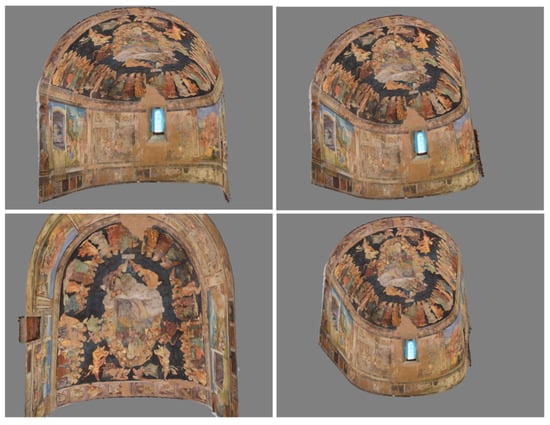
Figure 1.
Four views of the apsidal conch from the 3D rendering model.
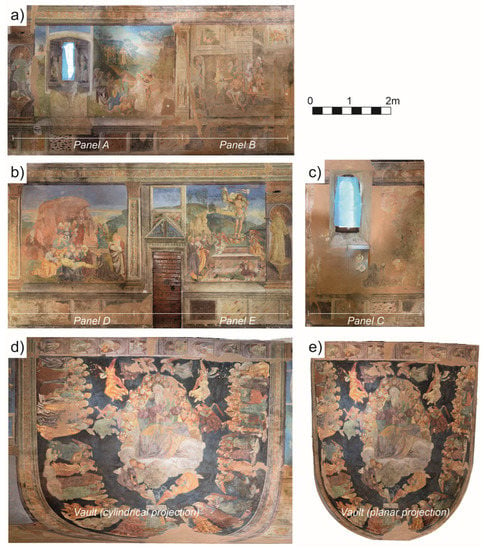
Figure 2.
Orthomosaics of the apsidal conch: (a) panels A and B depicting the Taking and the Flagellation of Christ, respectively; (b) panels D and E depicting the Deposition and the Resurrection of Christ, respectively; (c) panel C originally depicting the Crucifixion; (d,e) cylindrical and planar projections of the vault (not to scale) depicting God the Father along with the Angels and Blessed in Paradise.
The first scene on the left depicts the traitorous kiss of Judas and the capture of Christ (Panel A). In this scene, Judas, at the head of armed men, equipped with torches and lanterns, arrives in the Garden of Olives and greets Jesus with a traitorous kiss. As soon as Jesus is arrested, there is a reaction of dismay and at the same time defence on the part of the disciples: Peter, holding a sword and grabbing a servant of the high priest by the hair, is about to strike him and cut off his right ear; Jesus, with impressive calm, is moving towards Peter to stop him from his violent gesture but is stopped and arrested by the temple guards. Proceeding clockwise, we find the scene of the crowning with thorns where the soldiers, after having scourged Jesus, lead him to the palace of the governor Pilate, strip him of his clothes, put a red robe on him and a crown of thorny branches on his head, pressing it with sticks, outraging and mocking him as “King of the Jews” (Panel B). In the center of the apsidal circle, the fragmentary remains of the Crucifixion’s scene are visible, which must have been missing for a long time, so much so that a window was opened on that wall and enlarged in 1922 (Panel C) ([], p. 48). Continuing around the apse it is possible to observe the Deposition (Panel D): Christ, taken down from the cross, is on the knees of the Mother at whose side Mary Magdalene can be seen. The scene is observed on the right by the apostle John, and on the left by Giuseppe D’Arimatea who holds the nails of the Crucifixion in his hand. In the background, on the left, a slave of Giuseppe D’Arimatea can be seen holding a hammer and pincers used to detach Jesus from the cross; in the center three angels are depicted in front of the sepulchre ready to welcome the body of Christ.
The last panel on the right side depicts the scene of the Resurrection of Christ (Panel E). In this scene, the women amazed by the empty tomb listen with amazement to the words of the angel who, sitting on the tomb with a raised forefinger, tells them that Christ is risen. One of the three guards put in charge of the sepulchre is amazed at the noise of the earthquake and at the sight of the Lord’s angel, while the other two have fainted from fear. The Risen Christ, holding the banner of his triumph over death in his hand, elevated on a cloud as if supported by celestial spirits, is contemplated and adored by two angels in his resplendent glory.
The vault of the apse covers the scene of the glory of God. The Eternal Father is surrounded by angels and cherubs. On the right, the Madonna is surrounded by Holy Virgins, on the left Jesus is among the Apostles. In the background, there is Santa Cecilia among cheering angels holding musical instruments.
Just after the Resurrection, there is a niche that welcomes, under a shell, Fra Pietro dell’Aquila, a Franciscan friar known as Scotellus []. On the opposite side, mirroring the friar, St. Vito is represented with two dogs. In the splay of a small window, two extraordinary half figures of St. Jerome and St. Ambrose are painted.
Finally, between the last two scenes, namely that of the deposition and that of the resurrection, the artist has created an expedient to insert a real door in an architecture of pure fiction. Above, we observe a frame which, like a window, allows the landscape to flow from one scene to another without interruption. The small door is surmounted by a triangular tympanum with the coat of arms and surrounded by frames.
2. Experimental Section
2.1. 3D Photogrammetry
The 3D model of the apsidal conch of St. Panfilo church was obtained by applying a photogrammetric approach that required the preliminary acquisition of the necessary frames, totaling 156. To do this, a Nikon D5300 digital SLR camera (Tokyo, Japan), equipped with a 17/35 mm multifocal lens, was used. To obtain the photos, the camera was mounted on a tripod and the exposure parameters were set from time to time to ensure the correct exposure with every shot. For each frame acquisition, two white LED lamps (E27 85W CFL bulb lamps, 5500 K daylight colour) were positioned on both sides of the camera, at about 45° to the subject.
After the acquisition phase, performed on-site in the church, the 156 photographs were processed by the software Agisoft Metashape® (Saint Petersburg, Russia) that can photogrammetrically process digital images, aerial and close-range photographs to obtain 3D models with the advantage of generating photorealistic surfaces.
The used software is based on the Structure from Motion (SfM) approach that, thanks to the high degree of overlapping of the acquired photos, can cover the complete geometry of the object to be rendered. This characteristic of the approach gives it the name SfM, i.e., “structure derived from a motion sensor” [].
The working flow, widely explained elsewhere [], enables generation of a dense points cloud that is used to generate a polygonal model (mesh), which can be texturized to return a photorealistic 3D digital model.
For the 3D model sizing of the presbytery of San Panfilo church, 10 targets were positioned on the walls, whose coordinates (x, y, z; relative to a local geographical reference system) were measured with a Total Station model Topcon GPT 7005 with angular accuracy 5″. This system guarantees a sizing of the model achieving sub-centimeter precision. The captured frames were saved in .jpg format with 24 MP resolution, 24-bit sRGB depth; each frame size was about 6 MB. The images were processed on a workstation with the following specifications: Intel(R) Core processor (TM) i7-4770 CPU @ 3.40 GHz; Ram 32 GB; 64-bit system, Windows 10®; GeForce GTX 970 4Gb video card.2.2., equipped with constructing bits RGB.
2.2. Raking Light Photography
RAK photography is a useful and simple technique for examining works of art; it allows us to detect and document surface features, especially when we are looking for details that are not visible to the naked eye and are viewed in straight light (Figure 3). For paintings, RAK photography is used to obtain information about their state of conservation and use of preparatory techniques, to document, for instance, colour retouching and loss, as well as incisions, and to study the painting technique, as this can make clear the brushwork and layering of the paints []. Closer examination also reveals the junctions between giornate, i.e., the Italian term used to describe the amount of fresco painting that has been performed in a single day, and pontate (ponte, Italian for scaffolding), in which the plaster is laid in horizontal bands.
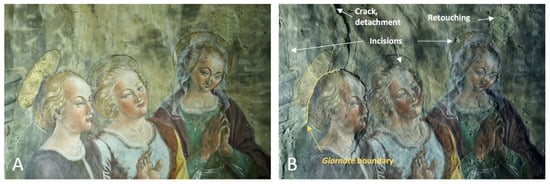
Figure 3.
Detail of panel E. (A) image obtained in straight light; (B) image obtained in raking light. All the details of the picture are emphasized in (B) where it is possible to observe the giornata boundary, incisions, detachment, retouching and crack.
Usually, the paintings are studied through photographs taken under diffused light conditions to avoid any reflection on the surface and to create the best lighting conditions under which the composition and colours can be better observed.
In the RAK technique, the paintings are enlightened in the visible band (400–780 nm) from one side only, at an oblique angle to the surface; in this way, the painted surface textures facing toward the light source are accentuated by the illumination, while those on the opposite side form shadows [].
In this work, the raking light images were obtained through a Nikon D7000 camera, illuminating the painted surface through a LED halogen light (500W MX 500 EV) at different angles depending on the specific requirements. The entire surface of the apsidal conch was examined and photographed. The details of the painting observed through the RAK technique were described according to the literature [].
2.3. Damage Diagnosis
The five panels (labelled from A to E) and the vault of the apsidal conch were exported as orthomosaics from the 3D model and then imported into CAD software for semi-quantitative damage diagnosis based on a monument mapping procedure of materials, weathering forms and damage categories. The weathering forms and the six damage categories were described according to the literature [,,,,]. The linear damage index (DIlin) and the progressive damage index (DIprog) were estimated as follows:
where b–f are the percentage areas of categories 1, 2, 3, 4 and 5, respectively. DIprog and DIlin range from 0 to 5 and represent, respectively, a rating of the higher damage categories and an average of them.
DIlin = [b + (c × 2) + (d × 3) + (e × 4) + (f × 5)]/100
DIprog = {[b + (c × 4) + (d × 9) + (e × 16) + (f × 25)]/100)}0.5
3. Results
3.1. 3D Photogrammetry
The very-high-resolution photorealistic rendering of the 3D spatial data generated by means of the Agisoft Metashape® software (professional education version 1.7 for universities) product directed our methodological choice, supporting a photogrammetric approach instead of use of a range-based system (e.g., TOF laser scanner). The two systems guarantee a comparable metrological precision of the measured 3D spatial data, but Metashape® has the further advantage in its workflow of creating a model rendered with a photographic resolution not achievable with the laser scanner. Furthermore, a non-secondary aspect is that the photogrammetric process requires low-cost investment when compared with range-based technologies.
This photogrammetric survey made it possible to obtain a three-dimensional, navigable and explorable model, which could also be viewed interactively in pdf format files (Figure S1).
Furthermore, the model has been uploaded to the Sketchfab platform in a non-public form, but can be made publicly visible, as carried out for other 3D models created by the University of Tuscia group [,]. The Sketchfab link is: https://sketchfab.com/models/88de7bbf64944408ad5fdda1d6eda141.
Moreover, Figure 1 shows additional views of the 3D model. The model can be used for mapping the state of conservation, the execution techniques, the eventual restoration areas and for georeferencing the analysis performed in the various part of the painting on the occasion of the development of the AIAr Tornimparte project.
3.2. Raking Light Photography
RAK photos of panels A, B, D, and E were taken to document the plaster work and painting technique, the preparatory drawings, and the decay phenomena of the mural painting surface. No RAK photos are available for panel C (the middle portion of the wall between panels B and D) where only a few small fragments of the mural painting have survived. With respect to this panel, the opening of a window, enlarged in 1922, has partly destroyed the mural painting with the restoration mortar covering a large part of the wall surface. Similarly, RAK photos relating to the splay window of panel A were not taken due to poor lighting and the position of the painting.
The paintings on panel A, depicting the Taking of Christ (Figure 4), display a high degree of deterioration, especially close to the window where rain infiltrated has caused localised detachments in the plaster. On the left of panel A there is a niche in which St. Vito is represented. Here, the RAK photos revealed some areas displaying colour loss and retouching (Figure 5A).
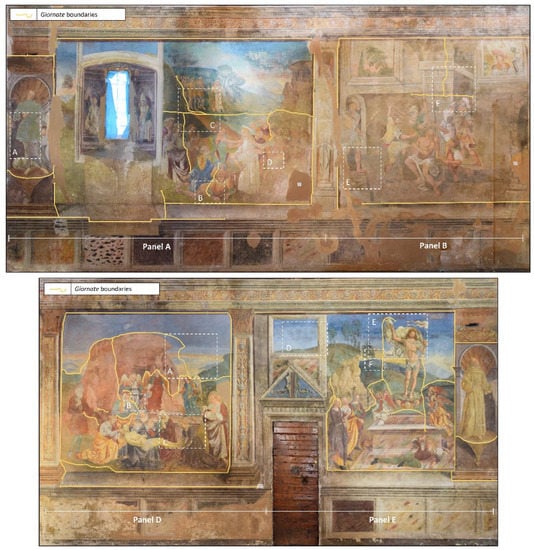
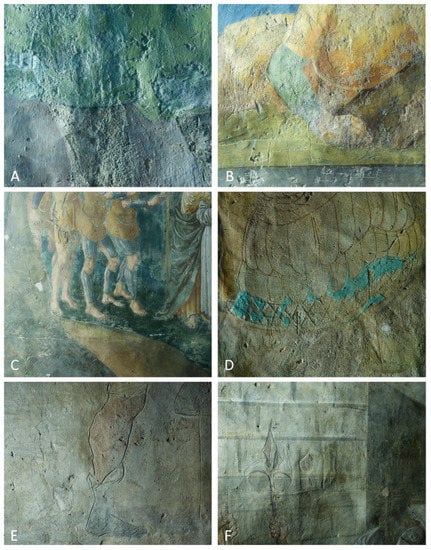
Figure 5.
Raking light photos obtained on the niche (left of panel A) and panels A and B showing retouchment (A), incisions (A,D–F), loss of colours (A–D), graffiti (B), thick brushstrokes of paint and a network of small cracks (E).
In panel A, the raking light highlighted the presence of graffiti (Figure 5B); examples of giornate and pontate boundaries are visible in Figure 5C, while colour losses and incisions can be observed in Figure 5B,D. Interestingly, in panel A, the raking light revealed the presence of a sort of landscape (Figure 6) depicting a monumental door and some religious buildings. The meaning and the origin of this detail remain unknown; we could assume a derivation from existing churches. Nevertheless, it was obviously covered by the blue sky in the background and can be classified as an example of rethinking.
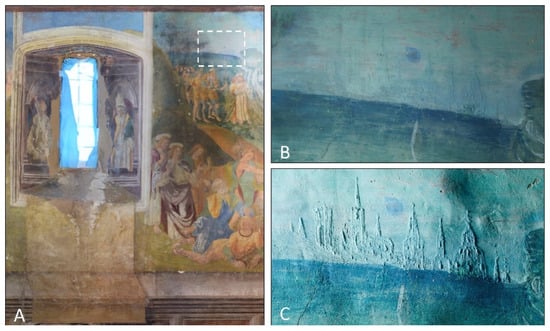
Figure 6.
(A) Image of panel A; (B) Enlarged image of the squared area reported in A; (C) Raking light photo of the B area.
Panel B (Flagellation of Christ) shows the worst state of conservation. In the original part of the painting numerous small cracks and thick brushstrokes of paint are visible as well as several incisions outlining details and figures (Figure 5E,F). The boundaries of giornate and the horizontal joins of pontate can be observed in Figure 5F.
Panels D and E (Deposition and Resurrection of Christ, respectively; Figure 4) are better preserved. The RAK photographs revealed some evident rethinking, such as the shape of the mountain in panel D (Figure 7A). In addition, giornate boundaries (e.g., Figure 7A,B) and several areas affected by colour loss, detachment and retouching (Figure 7C,D) were observed in panel D. The last panel on the right (panel E) showed spatula signs in the frame over the door (Figure 7D) and a layer of morellone below the blue sky (Figure 7E), as well as giornate boundaries (Figure 7E,F); retouching, colour loss and rethinking, such as the position of the tree branches (Figure 7F), were highlighted by the raking light.
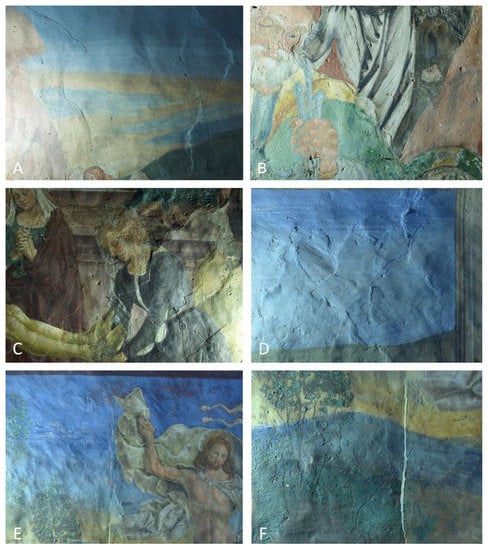
Figure 7.
Raking light photos obtained on the panels D and E showing giornate and pontate boundaries (A,B,E,F), rethinking (A,F), network of small cracks (C), spatula signs (D), colour loss (F). In (E) is also visible a layer of morellone under the blue sky.
Finally, to the right of panel E, another niche hosts the painting of the Franciscan friar Fra Pietro dell’Aquila. The painting shows numerous small cracks, loss of material and retouching.
The acquired pictures revealed that the plaster was laid inside the chapel walls by giornate and pontate, suggesting the use of fresco technique, with areas painted a secco (details about petrographic features and the microstratigraphy of the mortar-based materials are reported in []). Furthermore, the presence of a morellone layer under the blue sky background indicates the possible application of azurite with an organic binder. Finally, according to Cosentino et al. [], the widespread presence of thick brushstokes in many scenes of the painting suggests the addition of a binder to the pigments.
In panels A, D and E, the giornate boundaries generally delimit the landscape scene and the characters in the foreground; this may indicate the artist’s tendency to separate the work of the landscape from the more detailed work of the figures. In contrast, in panel B the giornate boundaries are barely visible; this is probably due to the numerous retouchings of the painting layer.
The contour lines, often following the outline of the characters, suggest that they were made by the pressure of a pointed tool. The presence of several incisions in areas showing a total loss of colour may help to reconstruct the original drawing; these areas seem to indicate that the colour spread was a secco, generally considered the less durable technique over time.
Examination of the RAK photos revealed the presence of several damage effects. Significant fractures and degradation forms are evident on the entire painted surface; however, the decay forms display a more pronounced level in the different panels (panels A and B are in worse condition than the D and E panels) possibly imputable to the different environmental exposure, the position of the walls, and the presence of a window in panel A []. In addition, several signs of anthropic damage, especially in the form of surface scratches, are visible in the lower part of the paintings. The poor conditions of conservation necessitated restoration work and several dry retouchings over the centuries, which eventually hid some of the giornata boundaries, making their identification difficult in some cases.
3.3. Mapping of Degradation Phenomena
The lower part of the apsidal conch consists of five panels depicting scenes from the New Testament (Figure 2). Nevertheless, only panels A, D and E show original paintings with well recognizable scenes. Conversely, the flagellation of Christ depicted on the panel C is not recognizable because of the creation of a new painting during the XVII century []. Lastly, the original painting of panel C, which was originally supposed to depict the Crucifixion, has completely disappeared due to extensive restoration works.
According to the geomaterial distribution map (Figure 8), most of the examined surface (ca. 87%) is covered by mural painting whereas the remaining part shows openings (2%) and restoration mortar (11%). The latter is mainly observable in the lower part of the apsidal conch, particularly in panel C.
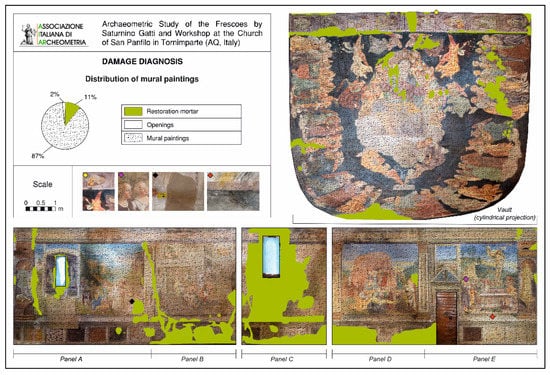
Figure 8.
Distribution of geomaterials for the five panels and the vault of the apsidal conch of St. Panfilo Church in Tornimparte (AQ, Italy). Coloured dots indicate the position of the acquired pictures in the wall paintings.
Among the main weathering forms (Figure S2 and Figure 9), individual fissures and intense networks of minor cracks (craquele), mainly extending on the decorated surfaces, can be observed. This kind of fissuring often evolves from minor detachments affecting the pictorial layers (Figure S2).
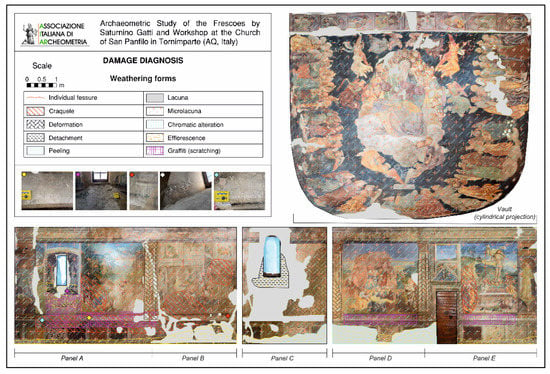
Figure 9.
Distribution of the weathering forms affecting the five panels and the vault of the apsidal conch of St. Panfilo Church in Tornimparte (AQ, Italy). Coloured dots indicate the position of the acquired pictures in the wall paintings.
Frequent missing parts of variable extension, from a few millimeters (micro-lacuna) to several centimeters (lacuna), are also noticed (Figure S2). The depth of these missing parts can interrupt the pictorial layer preserving (partially) the chromatic features of the mural painting or can reach the underlying plaster exposing the pouncing and incision marks. In the lower portion of the panels, it is possible to observe frequent graffiti (scratching) (Figure S2).
The chromatic alteration of the wall paintings is generally due to the concomitance of discoloration phenomena (bleaching), moisture trapping and surface deposits (Figure S2), as well as colour changes that are probably due to the transformation of azurite in malachite (Figure S2) [,]. In the map of the weathering forms (Figure 9), the whole painted surface is considered as a precaution.
The walls of the apsidal conch show a very irregular morphology (surface warping), alternating concave and convex profiles (Figure S2). The deformation of these surfaces can be attributed both to the preparation of the plaster and to sub-efflorescence and/or rising damp, responsible for localized blistering. Sub-efflorescence and efflorescence, with consequent detachment and disintegration, can also be observed on the restoration mortars near the windows of panels A and C (Figure S2) and along the lower part of the apsidal conch. There the pictorial film applied as chromatic integration shows frequent peeling.
Figure 10 proposes a preliminary mapping of the damage categories identified taking into account the type of material (painted surface or restoration mortar) and the overlapping of the main weathering forms, giving more importance to those that are associated with loss and/or destabilization of material (cracks and deformations, detachments, lacuna, etc.). The damage index estimated for the whole examined surface is close to 3.2, while it assumes the highest values in panels A and B (DIlin 3.6; DIprog 3.7) and lower values in the vault (DIlin 2.9; DIprog 3.0). There are no particular differences between the linear and progressive indexes.
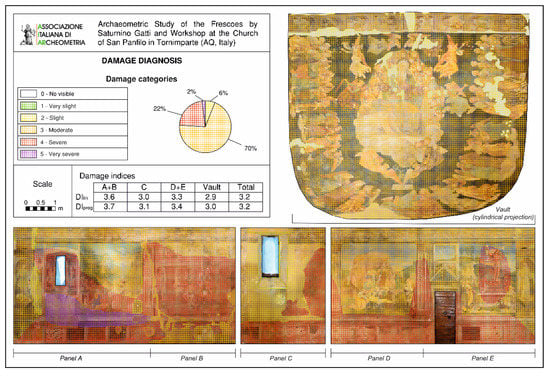
Figure 10.
Distribution of the damage categories for the five panels and the vault of the apsidal conch of St. Panfilo Church at Tornimparte (AQ, Italy).
4. Discussion and Conclusions
Documentation of a monument is a fundamental step to correctly plan and perform any restoration interventions. For this reason, the 3D photogrammetry of the apsidal conch of St. Panfilo Church in Tornimparte (AQ, Italy) represented the first and essential survey to perform and made it possible to export a three-dimensional, navigable and explorable model, using an interactive file in pdf format available in this paper as supplementary material (Figure S1).
The same model is also visible on Sketchfab platform using the link https://sketchfab.com/models/88de7bbf64944408ad5fdda1d6eda141.
As a result of the 3D photogrammetric survey, it was possible to export 2D images (i.e., orthomosaics) and to import them into CAD software for diagnosis of damage to the five panels and the vault of the apsidal conch, providing maps of the distribution of materials, weathering forms and damage categories.
As far as the state of conservation of the painted surfaces is concerned, the decorated apsidal conch of St. Panfilo Church shows a significant overlap of damage pathologies probably attributable to both the executive techniques and the microclimate conditions of the site for which more detailed information can be found in the other contributions of this Special Issue [,,,]. In fact, the occurrence of “a secco” painting areas, generally considered a less durable executive technique over time, could be responsible for most of the detachments affecting the pictorial layer. The microclimate conditions (i.e., high relative humidity) could facilitate the rising damp and surface deposition of efflorescence or sub-efflorescence with localized blistering, detachment and disintegration phenomena.
The bad state of conservation of these paintings could also be due to previous invasive restorations that affected the surfaces with heavy retouching and repainting. It is especially observed close to the openings of panel A and panel C where modern mortar-based materials have been used, probably leading to the occurrence of the observed degradation phenomena [,,].
The RAK photos of the examined panels were taken to document not only the decay phenomena of the mural painting surface but the painting technique and the preparatory drawings too. As a whole, the presence of incision marks (with minor pouncing), and the boundaries of giornate and pontate, clearly suggest the use of the fresco painting technique, although in several areas the color spread was a secco, especially where colour loss is observed. This fact is also suggested by the presence of a morellone layer under the blue sky background for the scene depicted on the panel E. Morellone was typically used in the secco painting technique. In this case, the blue pigment azurite (along with organic binder) was often used that easily turns into the green pigment malachite, as likely observed on panel A. In this area, thanks to the RAK photography, a clear example of rethinking depicting a monumental door and some religious buildings was observed.
It is also worthy of remark that the distribution of the giornate boundaries suggests that Saturnino Gatti generally had the tendency to separate the more detailed work of the figures of the scenes from the landscapes in the background. Nevertheless, a complete identification of the giornate boundaries was not possible since some of them were often hidden as a consequence of the several retouching and restoration works carried out over the centuries.
The present study shows how a documentation approach based on a multianalytical approach can provide a very important starting point for the restoration work of a complex monument, such as the wall painting in the church of St. Panfilo.
Lastly, as mentioned previously, this investigation represents a first digital documentation of the degradation phenomena affecting the Early Renaissance wall paintings realized by Saturnino Gatti during 1491–1494 in Tornimparte. The graphic contents here discussed, such as 3D photogrammetry (Figure 1 and Figure S1), raking light photography (Figure 3, Figure 5, Figure 6 and Figure 7) and damage mapping (Figure 8, Figure 9 and Figure 10) are able to illustrate the state of conservation of the monument before its restoration.
Supplementary Materials
The following supporting information can be downloaded at: https://www.mdpi.com/article/10.3390/app13095689/s1, Figure S1: interactive file in pdf format; Figure S2: weathering forms affecting the wall paintings.
Author Contributions
Conceptualization, data curation, writing—original draft preparation. F.B., S.C., F.I., L.L., C.P. and A.P.S.; Investigation, visualization, F.B., S.C., C.G., F.I., L.L., S.P., C.P. and A.P.S.; Supervision F.I., A.P.S. and C.P. All authors have read and agreed to the published version of the manuscript.
Funding
This work was performed in the framework of the Project Tornimparte—“Archaeometric investigation of the pictorial cycle of Saturnino Gatti in Tornimparte (AQ, Italy)” sponsored in 2021 by the Italian Association of Archaeometry AIAR (www.associazioneaiar.com).
Institutional Review Board Statement
Not applicable.
Informed Consent Statement
Not applicable.
Data Availability Statement
The data presented in this study are available on request from the authors.
Acknowledgments
The authors thank Domenico Fusari, President of PRO LOCO Association of Tornimparte, and Giacomo Carnicelli, Mayor of the municipality of Tornimparte for their support during the work activities. Moreover, the authors wish to give special thanks to the conservator Maria Fernanda Falcon Martinez and to the art historian Saverio Ricci of the Soprintendenza Archeologica, Belle Arti e Paesaggio per le province di l’Aquila e Teramo for their valuable suggestions and help during the measurements and in situ acquisitions.
Conflicts of Interest
The authors declare no conflict of interest.
References
- Arbace, L.; Di Paolo, G. I Volti Dell’anima, Saturnino Gatti: Vita e Opere Di Un Artista Del Rinascimento; Paolo De Siena Editore: Pescara, Italy, 2012; ISBN 8896341116. [Google Scholar]
- Mannetti, T.R.; Chelli, N.; Vecchioli, G. Saturnino Gatti Nella Chiesa Di San Panfilo a Tornimparte; L’Aquila Publishing: L’Aquila, Italy, 1992. [Google Scholar]
- Soler, F.; Melero, F.J.; Luzón, M.V. A Complete 3D Information System for Cultural Heritage Documentation. J. Cult. Herit. 2017, 23, 49–57. [Google Scholar] [CrossRef]
- Guarnieri, A.; Pirotti, F.; Vettore, A. Cultural Heritage Interactive 3D Models on the Web: An Approach Using Open Source and Free Software. J. Cult. Herit. 2010, 11, 350–353. [Google Scholar] [CrossRef]
- Yastikli, N. Documentation of Cultural Heritage Using Digital Photogrammetry and Laser Scanning. J. Cult. Herit. 2007, 8, 423–427. [Google Scholar] [CrossRef]
- Yilmaz, H.M.; Yakar, M.; Gulec, S.A.; Dulgerler, O.N. Importance of Digital Close-Range Photogrammetry in Documentation of Cultural Heritage. J. Cult. Herit. 2007, 8, 428–433. [Google Scholar] [CrossRef]
- Apollonio, F.I.; Basilissi, V.; Callieri, M.; Dellepiane, M.; Gaiani, M.; Ponchio, F.; Rizzo, F.; Rubino, A.R.; Scopigno, R.; Sobra’, G. A 3D-Centered Information System for the Documentation of a Complex Restoration Intervention. J. Cult. Herit. 2018, 29, 89–99. [Google Scholar] [CrossRef]
- Pelosi, C.; Calienno, L.; Fodaro, D.; Borrelli, E.; Rubino, A.R.; Sforzini, L.; Monaco, A. Lo An Integrated Approach to the Conservation of a Wooden Sculpture Representing Saint Joseph by the Workshop of Ignaz Günther (1727–1775): Analysis, Laser Cleaning and 3D Documentation. J. Cult. Herit. 2016, 17, 114–122. [Google Scholar] [CrossRef]
- Means, B.K. 3D Recording, Documentation and Management of Cultural Heritage. Hist. Archaeol. 2017, 51, 582–583. [Google Scholar] [CrossRef]
- UNI-EN16095; Conservation of Cultural Property: Condition Recording for Movable Cultural Heritage. European Committee for Standardization: Brussels, Belgium, 2012.
- Bentkowska-Kafel, A.; MacDonald, L. Digital Techniques for Documenting and Preserving Cultural Heritage; Arc Humanities Press: Yorkshire, UK, 2017; ISBN 9781942401346. [Google Scholar]
- Pavlidis, G.; Koutsoudis, A.; Arnaoutoglou, F.; Tsioukas, V.; Chamzas, C. Methods for 3D Digitization of Cultural Heritage. J. Cult. Herit. 2007, 8, 93–98. [Google Scholar] [CrossRef]
- Agosto, E.; Bornaz, L. 3D Models in Cultural Heritage: Approaches for Their Creation and Use. Int. J. Comput. Methods Herit. Sci. 2017, 1, 1–9. [Google Scholar] [CrossRef]
- Xiao, W.; Mills, J.; Guidi, G.; Rodríguez-Gonzálvez, P.; Gonizzi Barsanti, S.; González-Aguilera, D. Geoinformatics for the Conservation and Promotion of Cultural Heritage in Support of the UN Sustainable Development Goals. ISPRS J. Photogramm. Remote Sens. 2018, 142, 389–406. [Google Scholar] [CrossRef]
- Cosentino, A.; Gil, M.; Ribeiro, M.; Di Mauro, R. Technical Photography for Mural Paintings: The Newly Discovered Frescoes in Aci Sant’Antonio (Sicily, Italy). Conserv. Património 2014, 20, 23–33. [Google Scholar] [CrossRef]
- Zhang, J.; Kang, K.; Liu, D.; Yuan, Y.; Yanli, E. Vis4Heritage: Visual Analytics Approach on Grotto Wall Painting Degradations. IEEE Trans. Vis. Comput. Graph. 2013, 19, 1982–1991. [Google Scholar] [CrossRef] [PubMed]
- Chai, C.; de Brito, J.; Gaspar, L.; Silva, P.A. Predicting the Service Life of Exterior Wall Painting: Techno-Economic Analysis of Alternative Maintenance Strategies. J. Constr. Eng. Manag. 2014, 140, 4013057. [Google Scholar] [CrossRef]
- Langella, A.; Calcaterra, D.; Cappelletti, P.; Ciarcia, S.; D’Amore, M.; Di Martire, D.; Graziano, S.F.; de Gennaro, M. An Example of Integrated Geological Survey of Geomaterials and Their Weathering Forms: The Reggia Di Caserta Main Façade. Stud. Conserv. 2022, 1–13. [Google Scholar] [CrossRef]
- Fitzner, B. Documentation and Evaluation of Stone Damage on Monuments. In Proceedings of the 10th International Congress on Deterioration and Conservation of Stone, Stockholm, Sweden, 27 June–2 July 2004; Volume 27, pp. 677–690. [Google Scholar]
- Fitzner, B.; Heinrichs, K. Damage Diagnosis at Stone Monuments—Weathering Forms, Damage Categories and Damage Indices. Acta Univ. Carol. Geol. 2001, 1, 1–49. [Google Scholar]
- Fitzner, B.; Heinrichs, K.; La Bouchardiere, D. Damage Index for Stone Monuments. In Proceedings of the Protection and Conservation of the Cultural Heritage of the Mediterranean Cities. In Proceedings of the 5th International Symposium on the Conservation of Monuments in the Mediterranean Basin, Sevilla, Spain, 5–8 April 2000. [Google Scholar]
- Grifa, C.; Barba, S.; Fiorillo, F.; Germinario, C.; Izzo, F.; Mercurio, M.; Musmeci, D.; Potrandolfo, A.; Santoriello, A.; Toro, P.; et al. The Domus of Octavius Quartio in Pompeii: Damage Diagnosis of the Masonries and Frescoed Surfaces. Int. J. Conserv. Sci. 2016, 7, 885–900. [Google Scholar]
- Izzo, F.; Furno, A.; Cilenti, F.; Germinario, C.; Gorrasi, M.; Mercurio, M.; Langella, A.; Grifa, C. The Domus Domini Imperatoris Apicii Built by Frederick II along the Ancient Via Appia (Southern Italy): An Example of Damage Diagnosis for a Medieval Monument in Rural Environment. Constr. Build. Mater. 2020, 259, 119718. [Google Scholar] [CrossRef]
- Germinario, C.; Gorrasi, M.; Izzo, F.; Langella, A.; Limongiello, M.; Mercurio, M.; Musmeci, D.; Santoriello, A.; Grifa, C. Damage Diagnosis of Ponte Rotto, a Roman Bridge along the Ancient Appia. Int. J. Conserv. Sci. 2020, 11, 277–290. [Google Scholar]
- Randazzo, L.; Collina, M.; Ricca, M.; Barbieri, L.; Bruno, F.; Arcudi, A.; La Russa, M.F. Damage Indices and Photogrammetry for Decay Assessment of Stone-Built Cultural Heritage: The Case Study of the San Domenico Church Main Entrance Portal (South Calabria, Italy). Sustainability 2020, 12, 5198. [Google Scholar] [CrossRef]
- Galli, A.; Alberghina, M.F.; Re, A.; Magrini, D.; Grifa, C.; Ponterio, R.C.; La Russa, M.F. Special Issue: Results of the II National Research Project of AIAr: Archaeometric Study of the Frescoes by Saturnino Gatti and Workshop at the Church of San Panfilo in Tornimparte (AQ, Italy). Appl. Sci. 2023; to be submitted. [Google Scholar]
- Lowe, D.G. Distinctive Image Features from Scale-Invariant Keypoints. Int. J. Comput. Vis. 2004, 60, 91–110. [Google Scholar] [CrossRef]
- Lanteri, L.; Agresti, G.; Pelosi, C. A New Practical Approach for 3D Documentation in Ultraviolet Fluorescence and Infrared Reflectography of Polychromatic Sculptures as Fundamental Step in Restoration. Heritage 2019, 2, 207–215. [Google Scholar] [CrossRef]
- Garcia de Miguel, J.M. ICOMOS Illustrated Glossary on Stone Deterioration Patterns Glosario Ilustrado de Formas de Deterioro de La Piedra. In Monuments & Sites; ICOMOS: Paris, France, 2011; Volume 15. [Google Scholar]
- CNR; ICR. Raccomandazioni Normal: 1/88 Alterazioni Macroscopiche Dei Materiali Lapidei: Lessico; CNR; ICR: Rome, Italy, 1991. [Google Scholar]
- Colantonio, C.; Lanteri, L.; Ciccola, A.; Serafini, I.; Postorino, P.; Censorii, E.; Rotari, D.; Pelosi, C. Imaging Diagnostics Coupled with Non-Invasive and Micro-Invasive Analyses for the Restoration of Ethnographic Artifacts from French Polynesia. Heritage 2022, 5, 215–232. [Google Scholar] [CrossRef]
- Germinario, L.; Giannossa, L.C.; Lezzerini, M.; Mangone, A.; Mazzoli, C.; Pagnotta, S.; Spampinato, M.; Zoleo, A.; Eramo, G. Petrographic and Chemical Characterization of the Frescoes by Saturnino Gatti (Central Italy, 15th Century): Microstratigraphic Analyses on Thin Sections. Appl. Sci. 2023; to be submitted. [Google Scholar]
- Calandra, S.; Centauro, I.; Laureti, S.; Ricci, M.; Salvatici, T.; Sfarra, S. Sonic, Humidity and Thermal Imaging Methods for the Analysis of Decaying Frescoes of Apsidal Conch of San Panfilo Church. Appl. Sci. 2023; to be submitted. [Google Scholar]
- Briani, F.; Caridi, F.; Ferella, F.; Gueli, A.M.; Marchegiani, F.; Nisi, S.; Paladini, G.; Pecchioni, E.; Politi, G.; Santo, A.P.; et al. Multi-Technique Characterization of Painting Drawings of the Pictorial Cycle at the San Panfilo Church in Tornimparte. Appl. Sci. 2023; to be submitted. [Google Scholar]
- Comite, V.; Bergomi, A.; Lombardi, C.A.; Fermo, P. Characterization of Soluble Salts on the Frescoes by Saturnino Gatti in the Church of San Panfilo in Villagrande Di Tornimparte (L’Aquila). Appl. Sci. 2023; to be submitted. [Google Scholar]
- Ferrarese, S.; Bertoni, D.; Golzio, A.; Lanteri, L.; Pelosi, C.; Re, A. Microclimate Analysis of the San Panfilo Church in Tornimparte, Italy. Appl. Sci. 2023; to be submitted. [Google Scholar]
- Cultrone, G.; Arizzi, A.; Sebastián, E.; Rodriguez-Navarro, C. Sulfation of Calcitic and Dolomitic Lime Mortars in the Presence of Diesel Particulate Matter. Environ. Geol. 2008, 56, 741–752. [Google Scholar] [CrossRef]
- Izzo, F.; Grifa, C.; Germinario, C.; Mercurio, M.; De Bonis, A.; Tomay, L.; Langella, A. Production Technology of Mortar-Based Building Materials from the Arch of Trajan and the Roman Theatre in Benevento, Italy. Eur. Phys. J. Plus 2018, 133, 363. [Google Scholar] [CrossRef]
- Lubritto, C.; Ricci, P.; Germinario, C.; Izzo, F.; Mercurio, M.; Langella, A.; Cuenca, V.S.; Torres, I.M.; Fedi, M.; Grifa, C. Radiocarbon Dating of Mortars: Contamination Effects and Sample Characterisation. The Case-Study of Andalusian Medieval Castles (Jaén, Spain). Meas. J. Int. Meas. Confed. 2018, 118, 362–371. [Google Scholar] [CrossRef]
Disclaimer/Publisher’s Note: The statements, opinions and data contained in all publications are solely those of the individual author(s) and contributor(s) and not of MDPI and/or the editor(s). MDPI and/or the editor(s) disclaim responsibility for any injury to people or property resulting from any ideas, methods, instructions or products referred to in the content. |
© 2023 by the authors. Licensee MDPI, Basel, Switzerland. This article is an open access article distributed under the terms and conditions of the Creative Commons Attribution (CC BY) license (https://creativecommons.org/licenses/by/4.0/).